|
|
|
Sort Order |
|
|
|
Items / Page
|
|
|
|
|
|
|
| Srl | Item |
| 1 |
ID:
140977
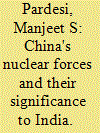

|
|
|
|
|
| Summary/Abstract |
The Indian nuclear program is a response to a perceived politico-strategic threat from China as opposed to a military-operational one that New Delhi began after perceiving an “ultimatum” from China in 1965. Consequently, India is in the process of acquiring an assured second-strike capability vis-à-vis China to meet the requirements of general deterrence. While India has always been concerned about the Sino-Pakistani nuclear/missile nexus, China has become wary of the growing military ties between the United States and India in recent years, especially because of the military implications of the US-India civil nuclear deal. Given the growing conventional military gap between the two states, India is not lowering its nuclear threshold to meet the Chinese conventional challenge. Instead, India is upgrading its conventional military strategy from dissuasion to deterrence against China. While the overall Sino-Indian nuclear relationship is stable, it will be challenged as China acquires advanced conventional weapons that blur the distinction between conventional and nuclear conflict.
|
|
|
|
|
|
|
|
|
|
|
|
|
|
|
|
| 2 |
ID:
140973
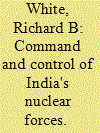

|
|
|
|
|
| Summary/Abstract |
The Indian government has not made a public comment about the status of its nuclear weapon program since approving a nuclear doctrine in 2003. However, there is now enough information in the public domain to determine that the command-and-control system for the nuclear program has steadily matured in accordance with the intent of the approved nuclear doctrine. The Indian government has successfully mitigated many of the issues that plague the conventional military. The result is a basic command-and-control system that is focused only on the delivery, if ordered by the prime minister, of nuclear weapons. The system is not as robust as those of the United States and Russia, but is in place and ready as new Indian nuclear weapons enter into operation. The command-and-control system is developing to meet India's needs and political compulsions, but not necessarily as part of a more assertive nuclear policy.
|
|
|
|
|
|
|
|
|
|
|
|
|
|
|
|
| 3 |
ID:
140975
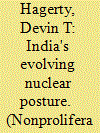

|
|
|
|
|
| Summary/Abstract |
This article analyzes India's nuclear doctrine, finding it to be critically flawed and inimical to strategic stability in South Asia. In pursuing an ambitious triad of nuclear forces, India is straying from the sensible course it charted after going overtly nuclear in 1998. In doing so, it is exacerbating the triangular nuclear dilemma stemming from India's simultaneous rivalries with China and Pakistan. Strategic instability is compounded by India's pursuit of conventional “proactive strategy options,” which have the potential to lead to uncontrollable nuclear escalation on the subcontinent. New Delhi should reaffirm and redefine its doctrine of minimum credible nuclear deterrence, based on small nuclear forces with sufficient redundancy and diversity to deter a first strike by either China or Pakistan. It should also reinvigorate its nuclear diplomacy and assume a leadership role in the evolving global nuclear weapon regime.
|
|
|
|
|
|
|
|
|
|
|
|
|
|
|
|
| 4 |
ID:
140979
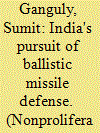

|
|
|
|
|
| Summary/Abstract |
This article analyzes India's efforts to deploy a Ballistic Missile Program (BMD). The article has three objectives. First, it argues that scientific-bureaucratic factors and India's incapacity to deter Pakistan's use of terrorist proxies have driven its quest for BMD. Second, the article also evaluates the current state of India's two-tiered missile defense shield. In spite of various claims on the part of India's defense science establishment, the paper estimates that India still lacks a deployable BMD system and is still far from developing an effective strategy of deterrence-through-denial. Third, the article analyzes the implications of the development of India's BMD system for nuclear stability in South Asia. The article shows how India's BMD capacities, however limited, have indirectly exacerbated the security concerns of India's regional rival, Pakistan.
|
|
|
|
|
|
|
|
|
|
|
|
|
|
|
|
| 5 |
ID:
140972
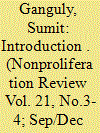

|
|
|
|
|
| Summary/Abstract |
The question of nuclear stability in South Asia is a subject of both academic and policy significance. It is the only region in the world that has three, contiguous nuclear-armed states: India, the People's Republic of China, and Pakistan. It is also freighted with unresolved border disputes. To compound matters, all three states are now modernizing their nuclear forces and have expressed scant interest in any form of regional arms control. These issues and developments constitute the basis of this special section, which explores the problems and prospects of nuclear crisis stability in the region.
|
|
|
|
|
|
|
|
|
|
|
|
|
|
|
|
| 6 |
ID:
140980
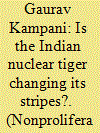

|
|
|
|
|
| Summary/Abstract |
Sixteen years after stepping out of the nuclear closet, India's nuclear posture, some of its operational practices, and hardware developments are beginning to mimic those of the original five nuclear weapon states. Several proliferation scholars in the United States contend that India's national security managers are poised to repeat the worst mistakes of the superpowers’ Cold War nuclear competition, with negative consequences for deterrence, crisis, and stability in South Asia and the Asia-Pacific region. This article takes a contrarian view. It dissects the best available data to show why the alarmist view is overstated. It argues that not only are the alarmists’ claims unsupported by evidence, their interpretation of the skeletal and often contradictory data threatens to construct the very threat they prophesize.
|
|
|
|
|
|
|
|
|
|
|
|
|
|
|
|
| 7 |
ID:
140981
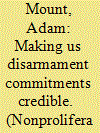

|
|
|
|
|
| Summary/Abstract |
President Barack Obama's 2009 commitment to pursue a world without nuclear weapons struck some as incredible given political resistance to arms control treaties and unilateral reductions. This viewpoint describes steps that can demonstrate a commitment to nuclear disarmament that do not rely on warhead dismantlement. These steps include the collation and release of nuclear data; the renovation and construction of facilities to new transparency standards; and the selective modification of conventional weapon systems. The steps may make a disarmament agreement more likely by assuaging the difficulty the United States will have committing to a verification scheme, given its capacity to circumvent such a scheme. A more credible disarmament pledge could also secure substantial fiscal and diplomatic gains.
|
|
|
|
|
|
|
|
|
|
|
|
|
|
|
|
| 8 |
ID:
140974


|
|
|
|
|
| Summary/Abstract |
Pakistan, the fastest growing nuclear weapon state in the world, has established over the last decade a nuclear management system it holds to be “foolproof.” Despite the explosion of radical groups challenging the writ of the state, it dismisses concerns by critics that its nuclear weapons are not safe and secure as “preposterous” and an attempt to “malign” the state. This article examines Pakistan's nuclear management system in four functional areas: command-and-control, physical security, nuclear surety, and doctrine. It describes what is publicly known in each area, identifies areas of omission and inadequacy in each one, and examines several premises of the nuclear program the author considers to be unfounded. Comparing these deficiencies in Pakistan's nuclear management system to the current problems plaguing the US nuclear management system, the author concludes that complacency and unfounded confidence in the efficacy of such programs, if not addressed and corrected, could lead to a future nuclear catastrophe in South Asia.
|
|
|
|
|
|
|
|
|
|
|
|
|
|
|
|
| 9 |
ID:
140976


|
|
|
|
|
| Summary/Abstract |
This essay provides an overview of the ongoing quantitative and qualitative changes in Pakistan's nuclear arsenal and their impact on deterrence stability vis-à-vis India. Prominent among these trends is a major expansion in fissile material production that enables the manufacture of lighter and more compact warheads optimized for battlefield missions; the development of cruise missiles and shorter-range ballistic missiles possessing dual-use capabilities; and a greater emphasis in doctrinal pronouncements on the need for strike options geared to all levels of conflict. Although these trends pose problematic ramifications for the risks of unauthorized and inadvertent escalation, deterrence stability in South Asia is not as precarious as many observers fear. The challenges of fashioning a robust nuclear peace between India and Pakistan cannot be lightly dismissed, however, and policy makers would do well to undertake some reinforcing measures.
|
|
|
|
|
|
|
|
|
|
|
|
|
|
|
|
| 10 |
ID:
140978


|
|
|
|
|
| Summary/Abstract |
While recent history arguably demonstrates a high level of nuclear stability in South Asia, this article argues that this stability has historically been a function of India's relative weakness. It argues that, as India becomes stronger, attention must be paid to the technical and political requirements of nuclear stability: the reliability of weapons and command and control and the political conditions that underpin stable relations between nuclear-armed states. It concludes by recommending the United States aim to modify the perceptions of regional elites about their various intentions and decision-making processes and the role of the United States as crisis manager.
|
|
|
|
|
|
|
|
|
|
|
|
|
|
|
|
| 11 |
ID:
140982
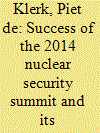

|
|
|
|
|
| Summary/Abstract |
The 2014 Nuclear Security Summit (NSS) in The Hague was a resounding success, both in organizational terms and in terms of substance. The new substance can be found in the Communiqué, as well as in innovative joint statements by participants, all of which may be considered as implementation of actions decided upon in the Final Document of the 2010 Review Conference of the Treaty on the Non-Proliferation of Nuclear Weapons. The next two years in the NSS process cannot be business as usual. This viewpoint makes some suggestions for NSS states to undertake between now and the final summit in 2016, including preparations for winding down the NSS process as we know it.
|
|
|
|
|
|
|
|
|
|
|
|
|
|
|
|
|
|
|
|
|